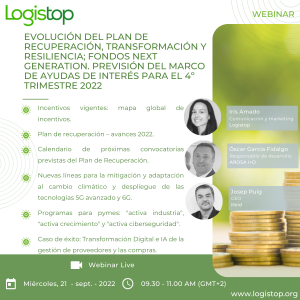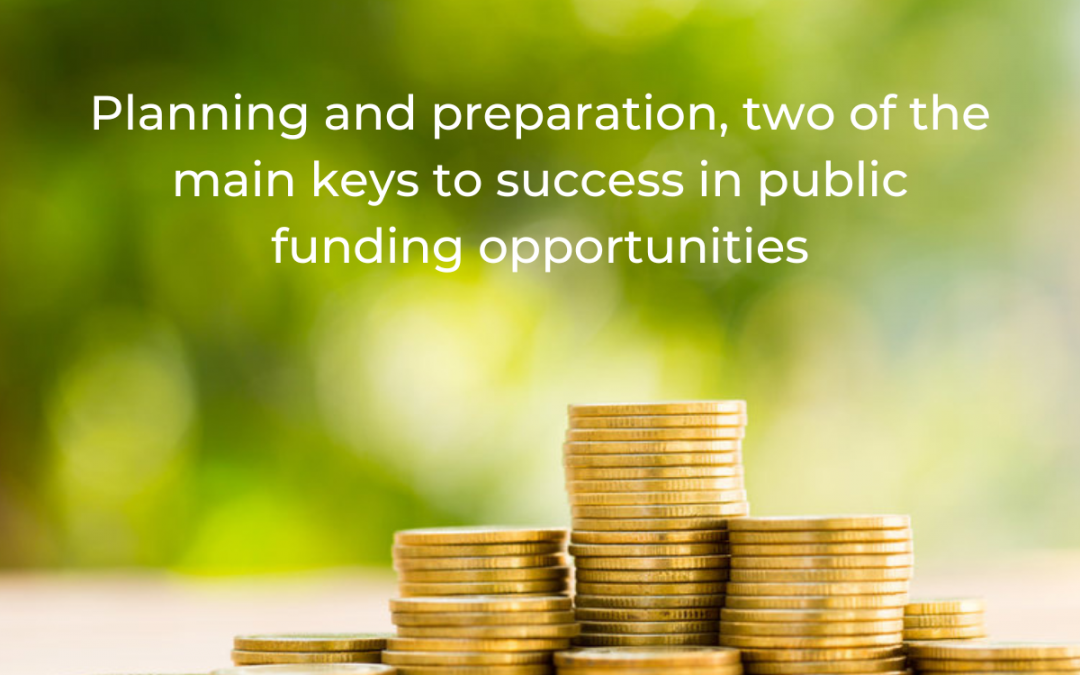- There are an average of 1,000 calls for proposals per year, so identifying which ones are of interest to your company is another key factor.
- The halfway point of the Recovery, Transformation and Resilience Plan is one of the best times to access public funding.
- In 2023, several calls for proposals (decarbonisation, circular economy…) are due to be published, to which traditional aid must be added.
In the Logistop Webinar “Evolution of the Recovery, Transformation and Resilience Plan; Next Generation Funds. Forecast of the aid framework of interest for the 4th quarter 2022”, the evolution of the PRTR during 2022 was presented, which has allowed us to draw a series of conclusions to be taken into account in order to foresee certain characteristics and common requirements when applying for future calls for proposals of interest.
To analyse these issues we had the participation of Óscar García Fidalgo, leader of the Public Funding working group, Logistop, and Head of Development, AROSA I+D, and Josep Puig, CEO, itbid, as well as the presentation of Iris Amado, Communication and Marketing, Logistop.

Evolution of the Recovery, Transformation and Resilience Plan
Within the ambitious Recovery, Transformation and Resilience Plan, most of the aid lines planned for this year with Next Generation EU funds have been called in the first half of 2022. Currently, we are practically at the halfway point of this distribution of public funds, being a good time to access the opportunities that are planned for the coming dates, since, from 2023 onwards, most of the actions planned are related to the implementation of the projects and not to new calls with Next Generation EU funds.
In this second half of the year, the publication of the resolutions for the award of these grants is expected, but the publication of other new lines aimed at digitisation and energy transition is also planned, which may be of interest given that the publication of calls related to the PERTES already approved is pending.
Apart from these lines, other public incentives remain in force, always available to companies through the Ministries, CDTI, IDAE and the Autonomous Communities themselves, which will promote business investment and innovation.
The key, as Óscar García Fidalgo points out, lies in identifying which funding line or call is appropriate for each company, as not all the calls for proposals that are published are suitable for all types of companies, autonomous communities or other conditioning factors.
When it comes to accessing this type of public funding opportunities, Óscar stresses that it is essential to have a prior project idea and to work on it, taking into account the characteristics of previous calls for proposals that have already been published, and he provides the following advice to follow in order to be successful:
- Identify the needs of the company.
- Identify the opportunities for public incentives.
- Plan the new projects to be developed and possible collaborations.
- Establish a strategy to take advantage of public incentives.
“When it comes to presenting a project to a public funding opportunity and being successful, one of the main keys is planning and preparation in advance, as well as knowing how to identify the available opportunities and their suitability to our characteristics as a company”
Óscar García Fidalgo, leader of the Public Funding working group, Logistop, and Head of Development, AROSA I+D
Public funding opportunities as a differential value
For his part, Josep Puig shared his experience of how the presentation to a public funding opportunity and its subsequent obtaining provided them with a differential value when implementing an innovation and digitalisation improvement in their company.
Based on his experience, Josep highlights the importance of having a previous work in which it is defined how the improvement to be implemented will improve the existing needs and the critical aspects detected. All of this channelling what type of project you have and want to implement and the existing financing possibilities and their characteristics.
Based on your experience, be clear about it, do not run after the project because the project could become lame. To channel what kind of project and the possibilities we have.
“The main challenge we had to face was the impossibility of tackling the project organically, only with our own resources. Therefore, after evaluating the options available to us, we considered that the existing public funding opportunities were a suitable option to implement our R&D project”
Josep Puig, CEO, itbid
About Logistop
Logistop is the benchmark workspace for collective innovation through the realisation of projects hand in hand with our members. Transforming the entire supply chain into a more efficient and sustainable one. All this with the aim of articulating and carrying out innovation projects among the members, without excluding the possibility of collaborating with or receiving support from certain organisations outside Logistop.

